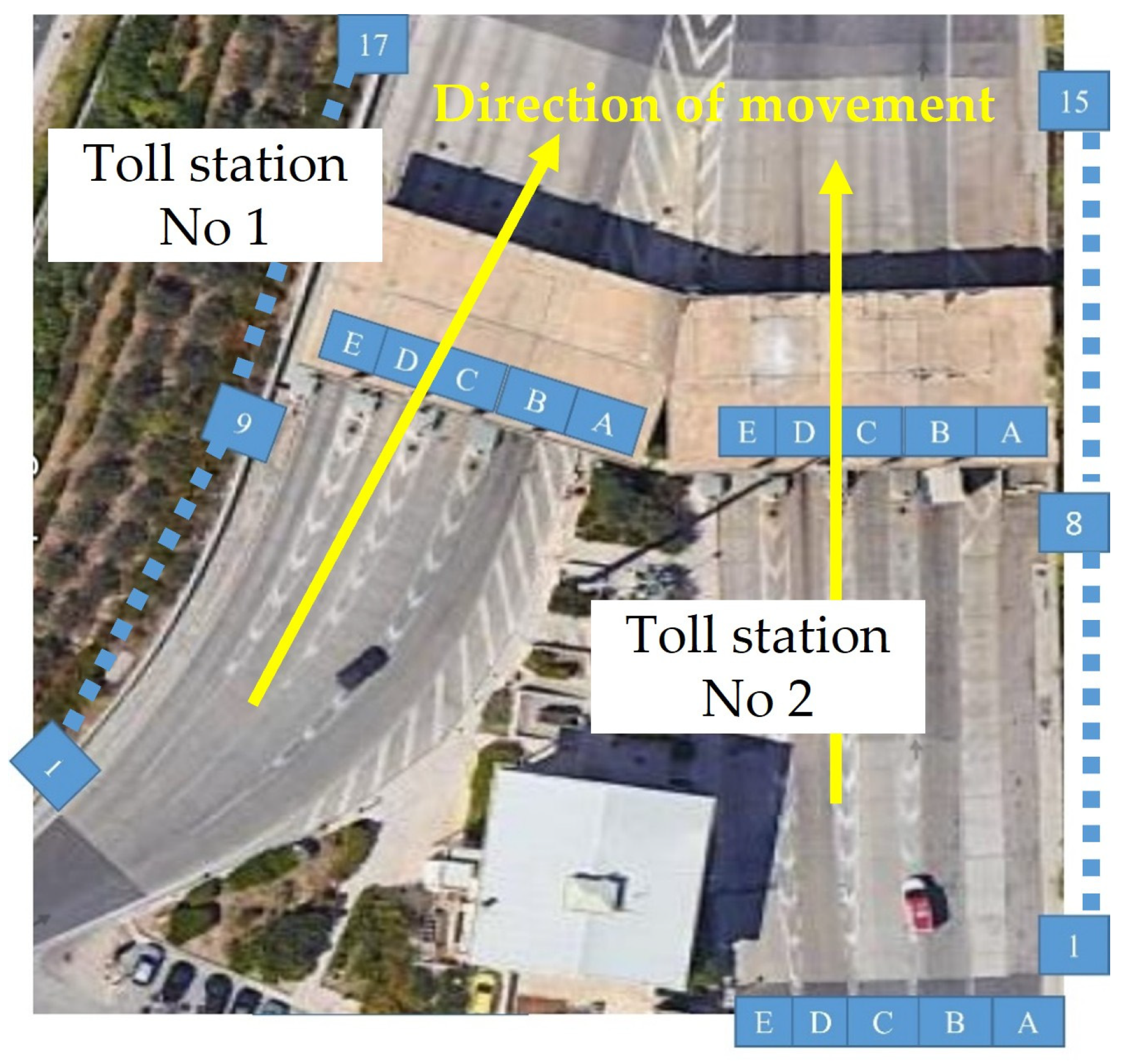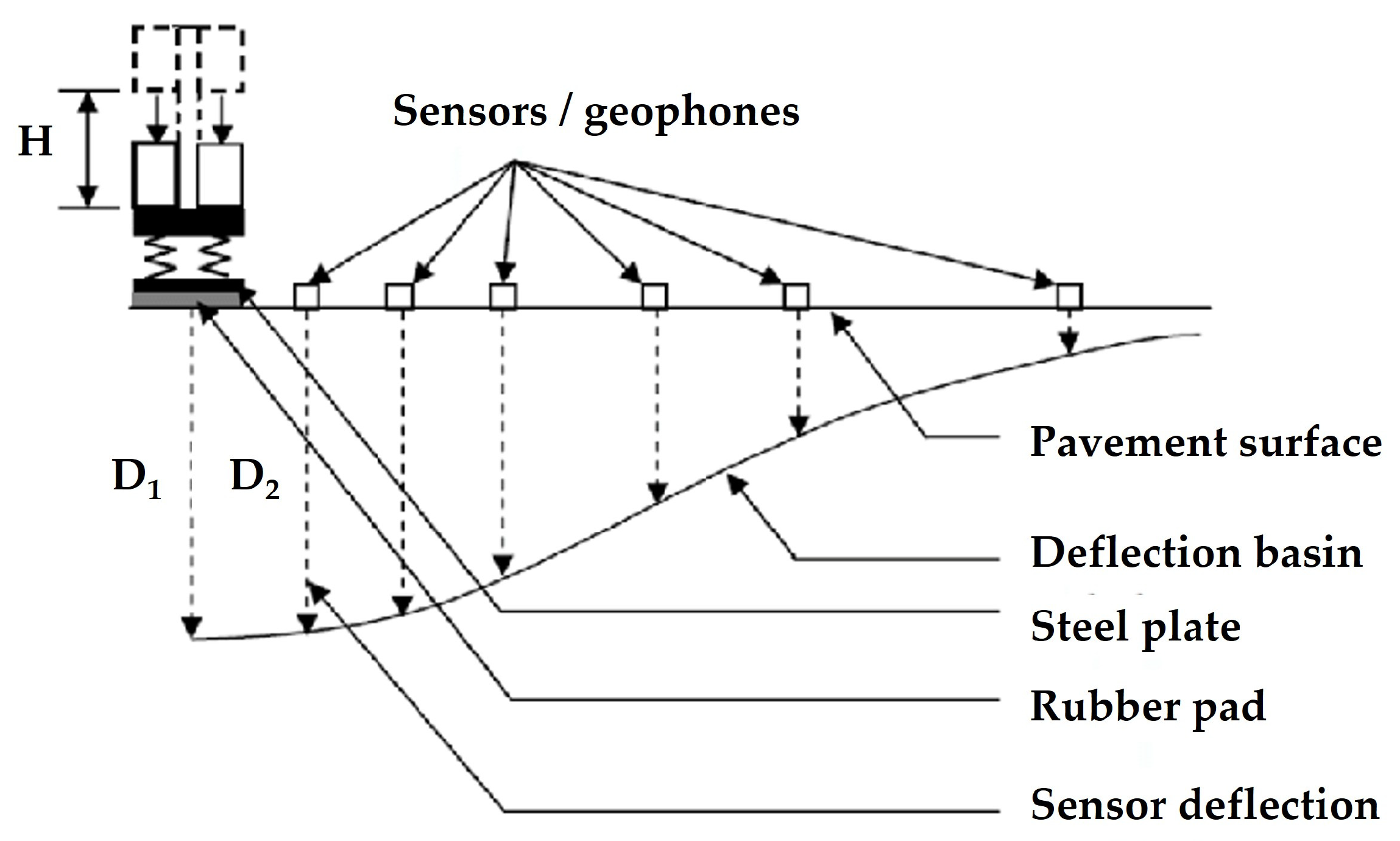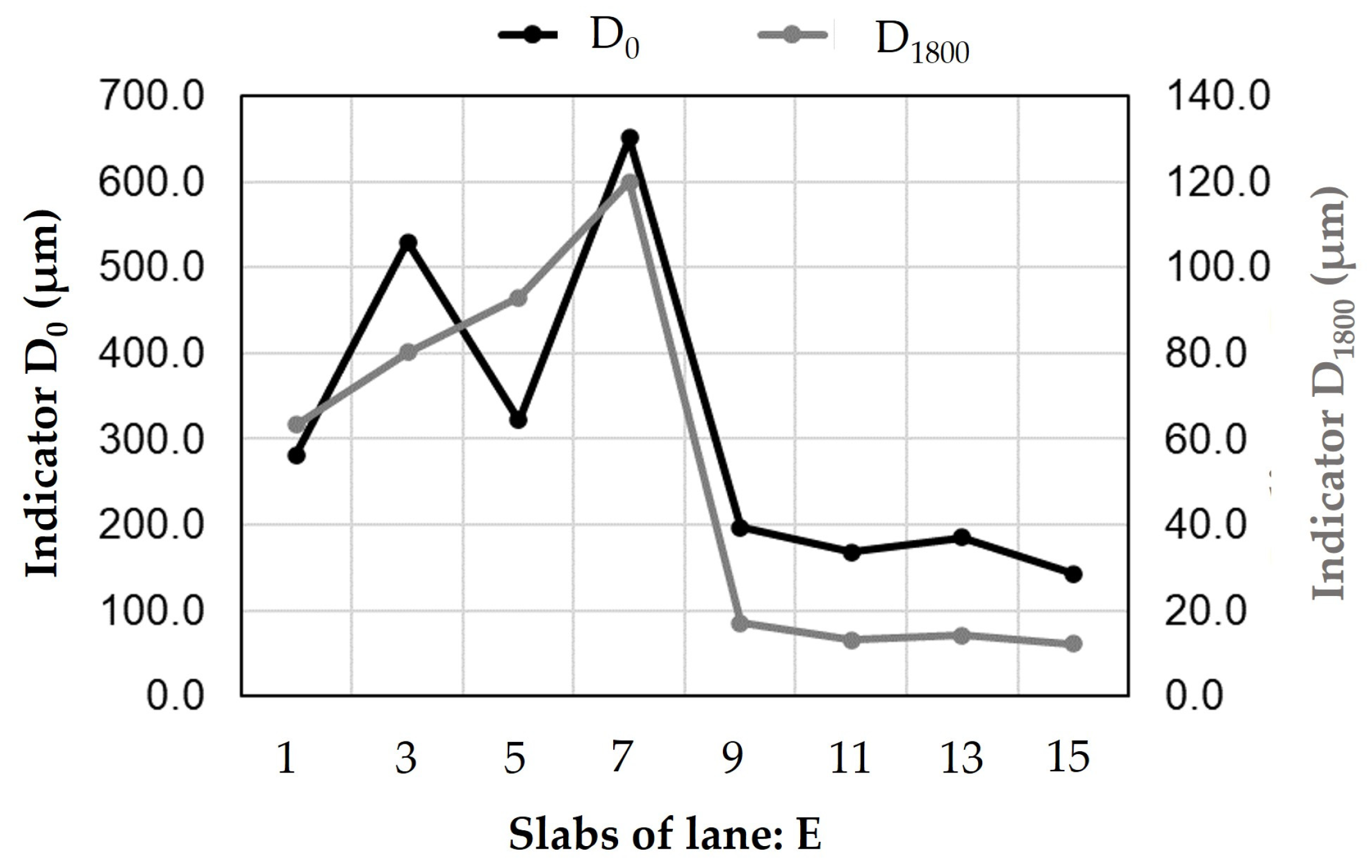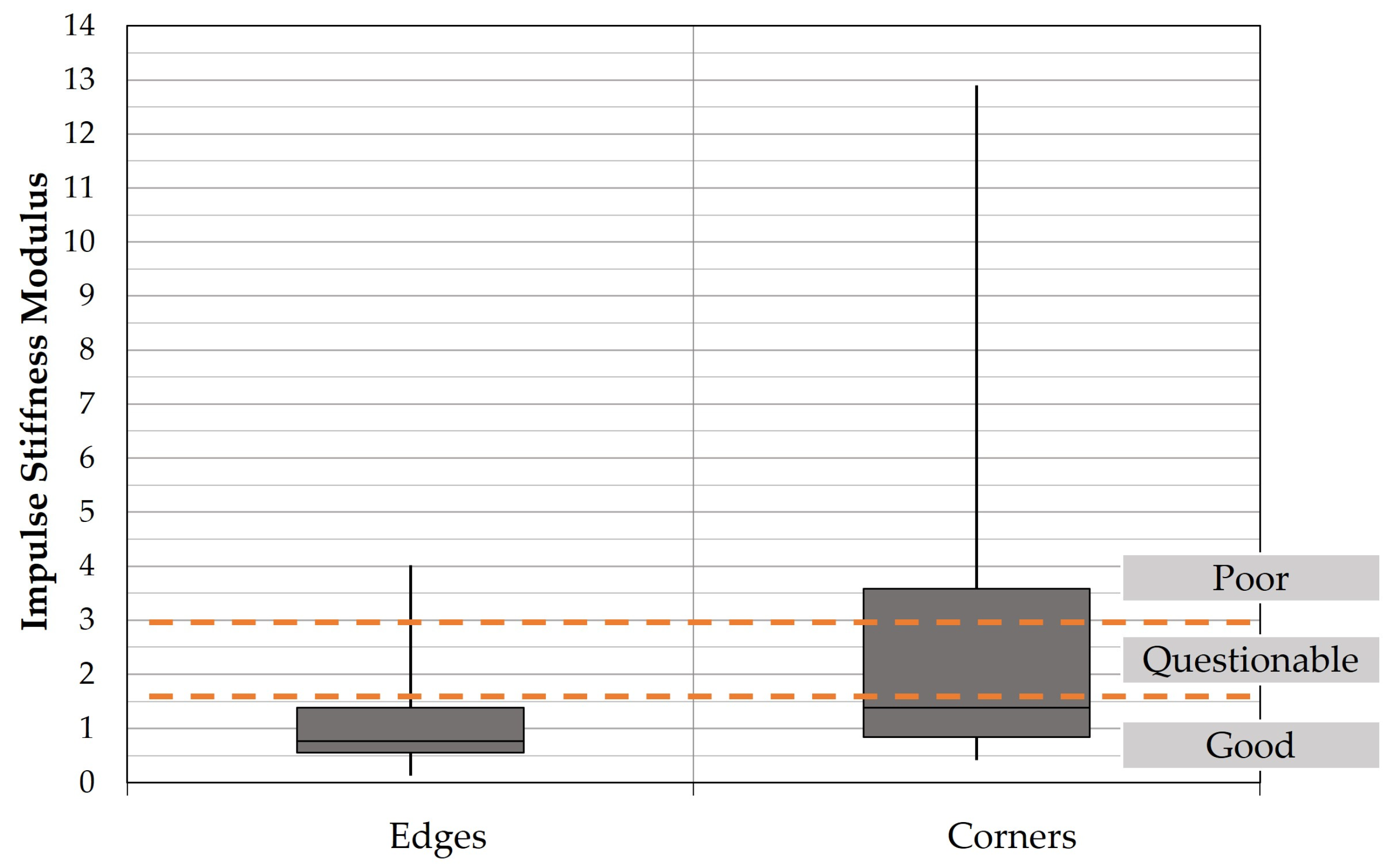Advancing Concrete Pavement Rehabilitation and Strategic Management Through Nondestructive Testing at Toll Stations
Abstract
1. Introduction
2. Materials and Methods
2.1. Test Site and Pavement Structure
2.2. Inspection Procedure
- D0 (μm): the maximum central deflection, recorded in the loading plate directly beneath the loading point. This indicator reflects the overall pavement condition.
- D1800 (μm): the deflection recorded from the outer sensor/geophone located at a distance of 1800 mm from the loading center. This indicator is known to reflect the substructure condition.
- : load and maximum deflection at the slab center;
- : location referring to either a slab edge or corner;
- : load and maximum deflection at the -location of a slab.
- : deflection (μm) recorded in the loaded slab, normally under the FWD plate (i.e., D0);
- : deflection (μm) recorded in the adjacent unloaded slab, usually at a radial distance of 300 mm from the FWD plate center (i.e., D300).
2.3. Conceptual Measures and Analysis
3. Results and Discussion
3.1. Deflectometric Indicators
3.2. Durability Assessment
3.3. Load Transfer Efficiency
3.4. Establishment of Criteria for Condition Assessment
- Deflectometric ranges increased across the study area, which required the definition of characteristic values through a distribution fitting analysis (characteristic D0 = 145 μm and characteristic D1800 = 13 μm).
- The assessment of durability did not yield significant anomalies. Despite some high ISM values at individual slab corners, these are not directly loaded, implying that the durability assessment is less critical for the present case.
- The LTE was satisfactory for the joints but showed a greater range for the cracks. Cracks with larger opening widths showed the lowest LTE values. The deflection indicators for the slabs with cracks were also of a higher order of magnitude than for the majority of the slabs. Therefore, it was assumed that the deflectometric assessment exceeded the LTE assessment.
4. Conclusions
4.1. Key Findings
- In situ deflectometric testing with the FWD detected changes in pavement slab deflections along the length of the lanes, with ranges of 50–1450 μm and 6–630 μm for the maximum deflection and the deflection of the outer geophone of the FWD, respectively.
- The age of the pavements and the observed deterioration in the serviceability of the pavements were related to these deflection changes observed for both indicators.
- Since field data reflect the “as is” condition of the pavement structures, decision-makers should rely on the produced results and their technoeconomic models for pavement management. Herein, the observed deflection ranges necessitated a probability analysis to define characteristic values that could reflect the condition of the majority of the pavement slabs investigated. These values were then increased to establish threshold values (or control values) that could classify the condition of the slabs and assist in the strategic management of pavements. In the present study, threshold values of D0 = 220 μm and D1800 = 20 μm were proposed.
- The assessment of durability proved to be less critical, as individual cases with durability problems at the slab corners were already accounted for by the high values of the deflectometric indicators. In the present study, threshold values found in the literature [28] were proposed.
- The LTE assessment showed relatively good conditions at the joints, while at the cracks, lower LTE values were consistent with the deflectometric indicators, indicating that lower LTE corresponded to higher deflectometric records. In the present study, a threshold value of 60% was proposed.
4.2. Prospects
Author Contributions
Funding
Institutional Review Board Statement
Informed Consent Statement
Data Availability Statement
Conflicts of Interest
References
- Qiao, M.; Wang, X.; Hou, R. Case Study: Validation of the Spectral-Analysis-of-Surface-Waves Method for Concrete Pavement Condition Evaluation. Appl. Sci. 2023, 13, 11410. [Google Scholar] [CrossRef]
- Golewski, G.L. The Phenomenon of Cracking in Cement Concretes and Reinforced Concrete Structures: The Mechanism of Cracks Formation, Causes of Their Initiation, Types and Places of Occurrence, and Methods of Detection—A Review. Buildings 2023, 13, 765. [Google Scholar] [CrossRef]
- César, A.; Pradena, M. Sustainable Engineering: Load Transfer Characterization for the Structural Design of Thinner Concrete Pavements. Sustainability 2020, 12, 9153. [Google Scholar] [CrossRef]
- Federal Highway Administration (FHWA). Concrete Pavement Rehabilitation: Guide for Load Transfer Restoration; Publication No. FHWA-SA-97-103; U.S. Department of Transportation: Washington, DC, USA, 1997.
- California Department of Transportation (Caltrans). Concrete Pavement Guide, Part 3: Preservation Strategies; Chapter 320—Individual Slab Replacement; Division of Maintenance Pavement Program: Sacramento, CA, USA, 2015. [Google Scholar]
- Rasol, M.A.; Pérez-Gracia, V.; Fernandes, F.M.; Pais, J.C.; Solla, M.; Santos, C. NDT assessment of rigid pavement damages with ground penetrating radar: Laboratory and field tests. Int. J. Pavement Eng. 2022, 23, 900–915. [Google Scholar] [CrossRef]
- Vinay Babu, S.; Ushasree, J.; Soundararajan, M.; Dubey, S.; Sathish, T.; Chandramauli, A. Comparative analysis of load transfer efficiency in plain and continuously reinforced concrete pavements. In Materials Today: Proceedings; Elsevier: Amsterdam, The Netherlands, 2023. [Google Scholar] [CrossRef]
- Sun, Y.; Yu, X.; Liu, Z.; Liu, Y.; Tao, J. Advanced Ultrasonic Technology for Freezing Damage Prevention of Concrete Pavement. Int. J. Pavement Res. Technol. 2013, 6, 86–92. [Google Scholar]
- Yaqoob, S.; Silfwerbrand, J.; Balieu, R.G.R. A Parametric Study Investigating the Dowel Bar Load Transfer Efficiency in Jointed Plain Concrete Pavement Using a Finite Element Model. Buildings 2024, 14, 1039. [Google Scholar] [CrossRef]
- Rao, S.; Roesler, J.R. Characterizing Effective Built-In Curling from Concrete Pavement Field Measurements. J. Transp. Eng. 2005, 131, 320–327. [Google Scholar] [CrossRef]
- Yasien, A.; Ghazy, A.; Bassuoni, M. Performance of Concrete Pavement Incorporating Portland Limestone Cement in Cold Weather. Sustainability 2022, 14, 183. [Google Scholar] [CrossRef]
- Pradena, M.; Houben, L. Sustainable Pavements: Influence of the Saw-Cutting Method on the Performance of JPCP. In Proceedings of the 14th International Multidisciplinary Scientific GeoConference SGEM 2014, Albena, Bulgaria, 17–26 June 2014. [Google Scholar]
- Kosar, K.; Khazanovich, L.; Salles, L. Evaluation of Early Age Concrete Pavement Strength by Combined Nondestructive Tests. Appl. Sci. 2023, 13, 2240. [Google Scholar] [CrossRef]
- Beshr, A.A.A.; Heneash, O.G.; Fawzy, H.E.D.; El-Banna, M.M. Condition assessment of rigid pavement using terrestrial laser scanner observations. Int. J. Pavement Eng. 2022, 23, 4248–4259. [Google Scholar] [CrossRef]
- Gkyrtis, K.; Armeni, A.; Plati, C.; Loizos, A. Structural Performance Assessment of Airfield Concrete Pavements Based on Field and Laboratory Data. Infrastructures 2021, 6, 173. [Google Scholar] [CrossRef]
- Březina, I.; Grošek, J.; Janků, M. Measurement of Deflections and Determination of Jointed Plain Concrete Pavements Stiffness by Falling Weight Deflectometer. Procedia Eng. 2017, 190, 162–169. [Google Scholar] [CrossRef]
- Lee, H.; Koirala, N.; Choi, P.; Seo, H. A Case Study on Distresses of Concrete Pavements Supported on a Retaining Wall. Appl. Sci. 2023, 13, 11226. [Google Scholar] [CrossRef]
- Chen, D.H.; Scullion, T.; Nam, B.H. Characterization of structural conditions for pavement rehabilitations. Constr. Build. Mater. 2016, 121, 664–675. [Google Scholar] [CrossRef]
- Kuo, C.-M.; Lin, C.-C.; Huang, C.-H.; Lai, Y.-C. Issues in Simulating Falling Weight Deflectometer Test on Concrete Pavements. KSCE J. Civ. Eng. 2016, 20, 702–708. [Google Scholar]
- Díaz Flores, R.; Donev, V.; Aminbaghai, M.; Zelaya-Lainez, L.; Blab, R.; Buchta, M.; Eberhardsteiner, L.; Pichler, B.L. Innovative FWD Testing on Concrete Slabs. In International RILEM Conference on Synergising Expertise towards Sustainability and Robustness of Cement-Based Materials and Concrete Structures; Jędrzejewska, A., Kanavaris, F., Azenha, M., Benboudjema, F., Schlicke, D., Eds.; SynerCrete 2023. RILEM Bookseries; Springer: Cham, Switzerland, 2023; Volume 43, pp. 460–472. [Google Scholar] [CrossRef]
- Liu, X.; Zhang, X. A new load bearing capacity assessment method of the road pavement based on surface strain and the spectrum of the acceleration. Discov. Appl. Sci. 2023, 5, 169. [Google Scholar] [CrossRef]
- Deep, P.; Andersen, M.B.; Thom, N.; Lo Presti, D. Toward the Development of Load Transfer Efficiency Evaluation of Rigid Pavements by a Rolling Wheel Deflectometer. Infrastructures 2020, 5, 7. [Google Scholar] [CrossRef]
- Solla, M.; Fernández, N. GPR analysis to detect subsidence: A case study on a loaded reinforced concrete pavement. Int. J. Pavement Eng. 2023, 24, 2027420. [Google Scholar] [CrossRef]
- Joshaghani, A.; Shokrabadi, M. Ground penetrating radar (GPR) applications in concrete pavements. Int. J. Pavement Eng. 2022, 23, 4504–4531. [Google Scholar] [CrossRef]
- Rasol, M.A.; Pérez-Gracia, V.; Solla, M.; Pais, J.C.; Fernandes, F.M.; Santos, C. An experimental and numerical approach to combine Ground Penetrating Radar and computational modeling for the identification of early cracking in cement concrete pavements. NDT E Int. 2020, 115, 102293. [Google Scholar] [CrossRef]
- Izevbekhai, B.I.; Khazanovich, L. Acoustic enhancement of concrete pavement surface through diamond grinding. Int. J. Pavement Eng. 2013, 14, 579–589. [Google Scholar] [CrossRef]
- Federal Highway Administration (FHWA). Distress Identification Manual for the Long-Term Pavement Performance Program; Publication No. FHWA-HRT-13-092; U.S. Department of Transportation: Washington, DC, USA, 2014.
- Federal Aviation Administration (FAA). Use of Nondestructive Testing in the Evaluation of Airport Pavements; Advisory Circular Νο: 150/5370-11B; U.S. Department of Transportation: Washington, DC, USA, 2011.
- Snyder, M.B. Guide to Dowel Load Transfer System for Jointed Concrete Roadway Pavements; Institute for Transportation at Iowa State University; National Concrete Consortium: Ames, IA, USA, 2011. [Google Scholar]
- BISAR. Shell Pavement Design Method. In BISAR PC User Manual; Shell International Petroleum Company Limited: London, UK, 1998. [Google Scholar]













| Statistics of D0 | Toll Station 1 | Toll Station 2 | Toll Station 3 | Toll Station 4 | Toll Station 5 |
|---|---|---|---|---|---|
| Min (μm) | 81.7 | 49.4 | 64.2 | 93.9 | 74.1 |
| Mean (μm) | 256.2 | 86.4 | 183.8 | 320.4 | 382.7 |
| St. Dev. (μm) | 141.0 | 43.6 | 85.7 | 264.9 | 370.6 |
| CV (dimensionless) | 55% | 51% | 47% | 83% | 97% |
| Max (μm) | 651.5 | 208.8 | 438.7 | 1437.8 | 1193.5 |
| Statistics of D1800 | Toll Station 1 | Toll Station 2 | Toll Station 3 | Toll Station 4 | Toll Station 5 |
|---|---|---|---|---|---|
| Min (μm) | 6.2 | 6.7 | 0.1 | 13.5 | 23.0 |
| Mean (μm) | 20.8 | 12.5 | 10.9 | 36.3 | 95.9 |
| St. Dev. (μm) | 20.2 | 3.5 | 6.1 | 28.7 | 165.9 |
| CV (dimensionless) | 97% | 28% | 56% | 79% | 173% |
| Max (μm) | 120.0 | 23.0 | 27.6 | 167.6 | 631.6 |
Disclaimer/Publisher’s Note: The statements, opinions and data contained in all publications are solely those of the individual author(s) and contributor(s) and not of MDPI and/or the editor(s). MDPI and/or the editor(s) disclaim responsibility for any injury to people or property resulting from any ideas, methods, instructions or products referred to in the content. |
© 2025 by the authors. Licensee MDPI, Basel, Switzerland. This article is an open access article distributed under the terms and conditions of the Creative Commons Attribution (CC BY) license (https://creativecommons.org/licenses/by/4.0/).
Share and Cite
Gkyrtis, K.; Plati, C.; Loizos, A. Advancing Concrete Pavement Rehabilitation and Strategic Management Through Nondestructive Testing at Toll Stations. Appl. Sci. 2025, 15, 5304. https://doi.org/10.3390/app15105304
Gkyrtis K, Plati C, Loizos A. Advancing Concrete Pavement Rehabilitation and Strategic Management Through Nondestructive Testing at Toll Stations. Applied Sciences. 2025; 15(10):5304. https://doi.org/10.3390/app15105304
Chicago/Turabian StyleGkyrtis, Konstantinos, Christina Plati, and Andreas Loizos. 2025. "Advancing Concrete Pavement Rehabilitation and Strategic Management Through Nondestructive Testing at Toll Stations" Applied Sciences 15, no. 10: 5304. https://doi.org/10.3390/app15105304
APA StyleGkyrtis, K., Plati, C., & Loizos, A. (2025). Advancing Concrete Pavement Rehabilitation and Strategic Management Through Nondestructive Testing at Toll Stations. Applied Sciences, 15(10), 5304. https://doi.org/10.3390/app15105304









